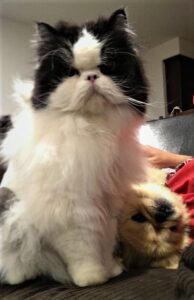If they Tell you They’re Just Not Hungry, They Might be FE-Lyin!
Cats are notorious for dramatic fits, long sessions of meowing, targeted revenge, and other forms of acting out if they can see bottom of a food dish, even if there is plenty of food still available. So, it’s unusual for your feline companion to suddenly stop eating for longer periods of time. Admittedly cats are finicky, so one could see a kitty go one to three days “just snacking” or having a full fledged hunger strike, only to find it’s just a cat being a stubborn cat. Skipping a few meals is all the rage in the Kitty Kingdom, so it may be the norm and not an exception for your fluff ball. In today’s Dog Blog, we’ll review a few non-medical reasons a cat could be taking a food “time-out”, as well as documented medical reasons that could turn serious.
 When it’s NOT CAT-ostrophic
When it’s NOT CAT-ostrophic
As we mentioned above, it’s purrrr-fectly in character for your kitty to lay off the grub for a few days. They can be very picky eaters that have mood and “tude” swings that will send them into a self-imposed food strike. Everyone knows of, or has heard a story, of a cat who would only eat one brand/type/recipe of cat food but when their owner bring home a huge bag or dozen cans… the cat refuses to eat that particular selection any longer. A cat can also take to mood swings that will cause them to eat more and eat less. Lastly, the constant self-maintenance and cleaning that your kitty is undergoing through will create hairballs in their tummy. These gross accumulations of hair don’t always sit right in your pets digestive system and make the cat reluctant to eat until they are gone.
They also can have upset tummies from something foreign or unusual that they get into. Cats can get indigestion or have acid reflux. Due to the sensitive nature of a cats tummy, feeding them table food should be a rare treat, if ever. You should also make sure your trash is secure and locked down.
Also keep in mind that cats are creatures of their own routine. So changes in environment can be as off-putting to them as change in food brand. Consider whats happening around them. Could there be something new that is causing stress in their lives? New people, a furry addition to the family, a new food dish, you moved their bed, or maybe YOU’RE stress is bleeding off to them, these are all real possibilities of why your cat has stopped visiting the chow line.
Old Age also brings change in appetite or frequency to eat. Simply, senior cats eat less (and prefer the “early bird special”… okay we made that part up). Their advanced years can also change their likes and dislikes, cause them to develop a sensitive tummy, and become unable to process certain ingredients or types of food. Your trusted veterinarian can suggest a “Senior” food that will be easier on the stomach but still carry all the needed nutrition. They can also simply eat less as they age.
Medical Reasons Your Cat is Not Eating
So What Do I Do if my Kitty is “Sans Food” for 3 to 4 days?
The answer to this question is easy… GET THEE TO A MEDICAL PROFESSIONAL THAT SPECIALIZES IN ANIMALS! (take them to their everyday veterinarian). This trusted healthcare provider will triage, diagnose, can come up with a treatment plan to, hopefully, fix what ails your kitty. If the cat show other signs of illness along with the lack of food intake… if they have a prolonged fever, if they are lethargic, or obviously in pain, then they need immediate attention, don’t wait for your everyday veterinarian to have an appointment opening. Know where your closest emergency animal hospital is located and have their number in your phone or hanging on the refrigerator.
Any veterinarian will want details, so be sure you’ve logged the symptoms and actions of the cat over the period they haven’t been eating. You’ll be asked questions like,
Having this type of detailed information helps piece together the when and how of the cats life and the days leading up to the visit. It may seem silly to you to be “up in” your cats business to this detail… but every detail is critical in this situation.
Hopefully the answer is something routine or environmentally driven and can be fixed with a small change, or time. In the cases of a more serious health issue the earlier its detected and diagnosed, the more runway you have for treatment and cure. So don’t delay, don’t think “oh it’s just a cat being a cat” and ignore the signs of a serious problem. Sure, cats are weird and quirky… but, if you’re a cat lover and owner, they are an important part of your life and family. Don’t be the person who is saying “how did I miss that” or “if only I had acted sooner”.
We hope this information is helpful to Feline Fanatics out there in the Freddie Nation and provided some tidbit you didn’t know. There are over 76 million cats in the United States, one in three households has a cat… often more than one. The reality is that in a world full of over 600 cats, there is only one cat this YOUR baby and they are irreplaceable.
Thanks for dropping in for this week Dog Blog. If you like what you read, keep in mind that we have a full library of pet related topics that range from medical to fun in nature. You’ll find over 60 blog listings at our web home. (www.freddiesplaceanimalhospital.com). Feel free to peruse the blogs and find something you’ll enjoy.
With spring in the air and the change of seasons, you’ll notice a growth in the population of fleas and ticks. During the month of March, Freddie’s Place Animal Hospital + Urgent Care is offering terrific discounts for flea and tick prevention all month long. Call the Best Care Anywhere Team at Freddie’s Place to find out more (call 760-Freddie).
Join us next week as we dig deep to bring you another topical session of our Dog Blog… we certainly hope to see you here. As always, until then, we wish you and your favorite fur friends the best of health, incredible fun time, good food and better company, and we ask that you always take the time to Be Pet Friendly, #FreddieSez!
Blog Research Sources





Leave A Comment